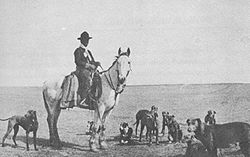
Wolfers
Encyclopedia

Wolf hunting
Wolf hunting is the practice of hunting grey wolves or other lupine animals. Wolves are mainly hunted for sport, for their skins, to protect livestock, and, in some rare cases, to protect humans. Wolves have been actively hunted since 12,000 to 13,000 years ago, when they first began to pose...
who operated in North America
North America
North America is a continent wholly within the Northern Hemisphere and almost wholly within the Western Hemisphere. It is also considered a northern subcontinent of the Americas...
in the 19th and early 20th centuries.
During the gold rush
Gold rush
A gold rush is a period of feverish migration of workers to an area that has had a dramatic discovery of gold. Major gold rushes took place in the 19th century in Australia, Brazil, Canada, South Africa, and the United States, while smaller gold rushes took place elsewhere.In the 19th and early...
es of the 1840s, 50s and 60s, 70s and 80s some of the participating men turned to wolfing when the harsh winters impeded their wagons. In 1860, the majority of wolfers were civilians who having failed to make their fortune on the great plains
Great Plains
The Great Plains are a broad expanse of flat land, much of it covered in prairie, steppe and grassland, which lies west of the Mississippi River and east of the Rocky Mountains in the United States and Canada. This area covers parts of the U.S...
through minerals, transport or land, worked as menial laborers who hunted wolves as a formal occupation for extra income. Though originally paid for wolf hides alone for the fur trade, wolfers were later paid extra for bounties. In the three decades after 1865, wolfers had almost exterminated every wolf from Texas
Texas
Texas is the second largest U.S. state by both area and population, and the largest state by area in the contiguous United States.The name, based on the Caddo word "Tejas" meaning "friends" or "allies", was applied by the Spanish to the Caddo themselves and to the region of their settlement in...
to the Dakotas, from Missouri
Missouri
Missouri is a US state located in the Midwestern United States, bordered by Iowa, Illinois, Kentucky, Tennessee, Arkansas, Oklahoma, Kansas and Nebraska. With a 2010 population of 5,988,927, Missouri is the 18th most populous state in the nation and the fifth most populous in the Midwest. It...
to Colorado
Colorado
Colorado is a U.S. state that encompasses much of the Rocky Mountains as well as the northeastern portion of the Colorado Plateau and the western edge of the Great Plains...
. It cost a wolfer about $150 to equip himself for a winter wolf hunt when the pelts were prime. An investment such as this could result in $1–3,000 pay for 3–4 months work. A typical method of killing wolves involved the shooting of a certain number of ungulates, lace the carcasses with strychnine
Strychnine
Strychnine is a highly toxic , colorless crystalline alkaloid used as a pesticide, particularly for killing small vertebrates such as birds and rodents. Strychnine causes muscular convulsions and eventually death through asphyxia or sheer exhaustion...
, then return the next day to find the poisoned wolves. The majority of commercial wolfers in the 1870s worked for ranchers. Wolfer activities peaked from 1875-1895 as cattlemen
Cowboy
A cowboy is an animal herder who tends cattle on ranches in North America, traditionally on horseback, and often performs a multitude of other ranch-related tasks. The historic American cowboy of the late 19th century arose from the vaquero traditions of northern Mexico and became a figure of...
increasingly blamed all economic shortalls on wolf depredation, resulting in some dedicated hunters laying down poison in lines of up to 150 miles. Acts of fraud in the claiming of wolf bounties were not uncommon in this period. In some cases, wolfers would kill wolf pups and deliberately spare the mother in order to allow her to breed again the next year. Others would show one magistrate a wolf body part, while showing another a body part from the same animal, thus getting paid twice for the same kill.
On July 1, 1915, the US government hired its first government wolf hunters. Unlike the civilian bounty hunters of the prior century, the government hunters approached their work methodically and soberly. Before being disbanded on June 30, 1942, the U.S government hunters killed over 24,132 wolves.
In Canada, a government backed wolf extermination programme was initiated in 1948 after serious declines in caribou herds in the Northern Territories
Northern Territories
Northern Territories may refer to several geographic locations:, a term used by the Japanese to refer to the territory disputed with Russia. See Kuril Islands dispute...
and a rabies
Rabies
Rabies is a viral disease that causes acute encephalitis in warm-blooded animals. It is zoonotic , most commonly by a bite from an infected animal. For a human, rabies is almost invariably fatal if post-exposure prophylaxis is not administered prior to the onset of severe symptoms...
concern due to wolves migrating south near populated areas. 39,960 cyanide guns, 106,100 cyanide cartridges and 628,000 strychnine pellets were distributed. Up to 17,500 wolves were poisoned in Canada between 1955 to 1961. In the mid-50s, wolf bounties were dropped in the western provinces in favour of hiring provincial hunters. Quebec's wolf bounties ended in 1971 and Ontario in 1972. Overall, 20,000 wolves were bountied between 1935-1955 in British Columbia, 12,000 between 1942-1955 in Alberta and 33,000 between 1947-1971 in Ontario.

